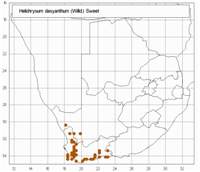Origin of name:
dasyanthus = with thickly hairy flowers
Diagnostic characters:
Leaves and stems covered in spreading hairsLeaves dark green above, yellowish belowCompact branched inflorescenceMedium sized headsOuter bracts woolly-hairyTips of outer bracts dark-coloured
Description:
Shrub or subshrub, erect to c. 1 m, or sprawling or straggling, branches long, thin, greyish-white woolly, long spreading hairs as well, these sometimes rufous, leafy, flowering twigs more distantly so. Leaves mostly 6-30 x 2.5-10 mm, becoming smaller below the heads, elliptic, oblong or oblong-lanceolate, sessile, apex obtuse or subacute, mucronate, sometimes recurved, margins subrevolute, often undulate, thinly greyish-white woolly above or wool sometimes wanting, long spreading hairs as well, whitish or rufous, thickly woolly below, also with spreading hairs. Heads heterogamous, campanulate, c. 4 x 3 mm, many in compact terminal corymbose panicles. Involucral bracts in 4-5 series, imbricate, graded, just overtopping flowers, silky-villous dorsally, outer lanceolate, often dark-tipped, inner oblong, tips rounded, glabrous, semi-opaque, pale straw-yellow, minutely radiating. Receptacle with fimbrils much exceeding the ovaries. Flowers 17-28, 3-10 female, occasionally with staminodes, 12-24 homogamous. Achenes c. 0.75 mm, those from homogamous flowers often c. one third smaller, barrel-shaped, obscurely ribbed, in female flowers with duplex hairs, not myxogenic, in homogamous flowers usually glabrous, very rarely hairy. Pappus bristles many, equaling corolla, barbellate, bases lightly fused as well as cohering by patent cilia.
Flowering mainly in September, October and November.
Distribution:
Along the littoral and on the mountain slopes, in fynbos and on the margins of dune scrub and forest. Confined to the W., SW. and S. Cape, from Kamieskroon and Kamiesberg in Namaqualand south through Vanrhynsdorp, Calvinia, Clanwilliam, Wuppertal and Worcester degree squares to the Peninsula, thence east through Simonstown, Caledon, Bredasdorp, Riversdale, Oudtshoorn and Mossel Bay degree squares to the environs of Willowmore, Knysna and Plettenberg Bay.
Fynbos Biome.
Notes:
Straggling specimens bear a superficial resemblance to H. capense, but are easily distinguished by the spreading hairs on stems and leaves, and the markedly fimbrilliferous, not smooth, receptacle. Also, there are many more heads in the inflorescence, the involucral bracts have distinctly glabrous tips and the ovaries of female and hermaphrodite flowers are usually different.
Taxonomy:
Literature:
Helichrysum dasyanthum (Willd.) Sweet. Hort. Brit. 223 (1826); Hilliard & Burtt in Bot. J. Linn. Soc. 82: 200 (1981).
Type:
Cape of Good Hope (sheet 15453, B-W).
Synonym(s):
Gnaphalium dasyanthum Willd., Enum. 865 (1809).
Gnaphalium maritimum L., Mant. alt. 283 (1771), non Hill (1769). Helichrysum maritimum D. Don in Sweet, Hort. Brit. 223 (1826); Less., Syn. Comp. 304 (1832); DC., Prodr. 6: 204 (1838); Harv. in F.C. 3: 248 (1865); Moeser in Bot. Jb. 44: 288 (1910); Levyns in Adamson & Salter, Fl. Cape Penins. 784 (1950). Type: Cape of Good Hope, seashore, Tulbagh 171 (LINN 989.29).
G. molle Thunb., Prodr. 150 (1800), Fl. Cap. 653 (1823), non Salisb. (1796). Type: Cape, French Hoek, Thunberg (sheet 19201, UPS, holo.).
Helichrysum maritimum var. microphyllum DC., Prodr. 6: 204 (1838); Harv. in F.C. 3: 248 (1865). Lectotype: Cape, Kamiesberge, alt. 4 000�5 000 ped., Dr�ge 5760 (G-DC).
Vouchers:
Compton 22181 (NBG); Esterhuysen 21912 (BOL; PRE); Esterhuysen 14692 (BOL; NBG); Tyson 708 (BOL; SAM); Werdermann & Oberdieck 511 (K; PRE); Acocks 22759 (PRE).

